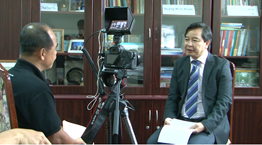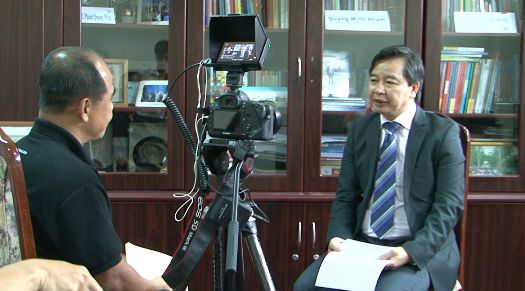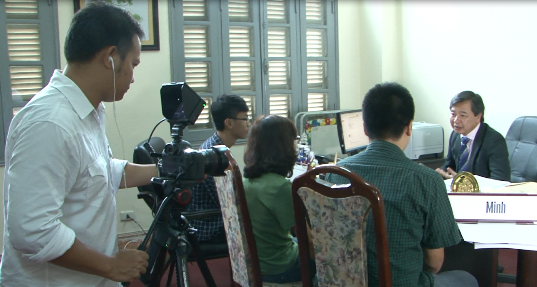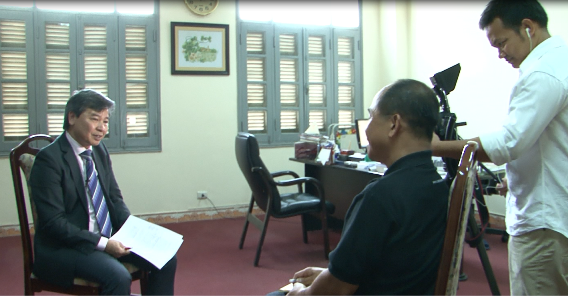
- VOA reporter: Sir, why do you believe that the disputed territory belongs to Vietnam??
Associate Professor, Dr. Pham Quang Minh:At least, there are four legal evidences affirming Vietnam's sovereignty over the Hoang Sa and Truong Sa archipelagos:
Firstly, since the end of the 19th century, the French colonialists ruled Vietnam and continuously carried out many activities to exercise their sovereignty over the two archipelagos of Hoang Sa and Truong Sa and publicly declared their sovereignty over these two archipelagos since 1933. France also maintained control over these two archipelagos until the end of World War II and officially transferred that right to the State of Vietnam on October 15, 1950.
Second, a series of international negotiations and declarations, including the Cairo Declaration of 1943, the Potsdam Declaration of 1945, the San Francisco Treaty of 1951, and even the Joint Declaration between the People's Republic of China and Japan in 1972, when the two countries normalized relations, did not list the Paracel and Spratly Islands among the territories that Japan had to return to China.
Third, at the San Francisco Conference held in September 1951, the Soviet Union's proposal to hand over the Paracel and Spratly Islands to China was opposed and rejected by representatives of 46 out of 51 countries attending the Conference. Also attending this Conference, the then Prime Minister of the State of Vietnam, Mr. Tran Van Huu, in the seventh session of the San Francisco Conference, declared: "To extinguish any seeds of dispute that may arise in the future, we affirm Vietnam's long-standing sovereignty over the Paracel and Spratly Islands." This declaration did not encounter any opposition or rejection from any of the countries attending the Conference.
Fourth, in the Geneva Conference to cease hostilities in Indochina in 1954, all participating countries, including the People's Republic of China, recognized the independence, sovereignty and territorial integrity of Vietnam, although Vietnam was temporarily divided at the 17th parallel, but the State of Vietnam at that time and the Republic of Vietnam later had the right to manage and exercise sovereignty over the two archipelagos of Hoang Sa and Truong Sa from 1954 to 1975. When the Resistance War against the US ended, the unified state of Vietnam - the Socialist Republic of Vietnam - immediately inherited and continuously exercised its sovereignty over the two archipelagos of Hoang Sa and Truong Sa that had been exercised by Vietnamese representatives earlier in history.
In short, these are undeniable international legal evidences of Vietnam's legitimate sovereignty over the Hoang Sa and Truong Sa archipelagos.

Interview scene (Photo: Dinh Hau)
- VOA reporter: Why is this territory so important to your country??
Associate Professor, Dr. Pham Quang Minh:This territory is important to Vietnam from many different perspectives:
Firstly, geographically, Vietnam is a maritime country, with a coastline of 3,260 km, more than 1 million km2 of sea surface and more than 100 deep-sea ports convenient for transportation. This coastline stretches across the territory of 29/63 provinces and cities of the country, where up to 20 million Vietnamese people live, accounting for more than ¼ of Vietnam's population.
Second, in terms of economy, it is estimated that the oil reserves in Vietnam's waters account for 25% of the total oil reserves in the East Sea. Every year, Vietnam exploits about 20 million tons of crude oil, contributing up to 24% of the country's GDP. In addition, also in the East Sea, Vietnam exploits about 1.5-1.8 million tons of seafood every year. Vietnam has exploitation cooperation with most of the major international oil and gas corporations such as VietsoPetro, BP, Total, ExxonMobil, Conoco Phillips.
Third, in terms of geostrategy, Vietnam is located on the world's busiest shipping route connecting the Indian Ocean and the Pacific Ocean, with more than 70% of goods from China, Japan and South Korea transported annually through this area, and more than 50% of the world's ships operating through this sea area. The East Sea also connects mainland Southeast Asia with island Southeast Asia, forming a unified entity. The East Sea is closely related to the peace and security of the entire Southeast Asia and Asia-Pacific region.

- VOA reporter: Why are these disputes becoming more intense now?
Associate Professor, Dr. Pham Quang Minh:Because after more than 3 decades of reform and opening up, China is rising, becoming a great power, with ambitions of global hegemony, threatening the number one position of the US. The East Sea is one of the important areas in the strategy of realizing China's dream. By bringing the Haiyang Shiyou 981 drilling rig deep into the continental shelf and exclusive economic zone of Vietnam in May 2014, China wants to test many different subjects at the same time.
First, for the US: China expressed its opposition to the US administration's "pivot" strategy toward Asia, especially after President Barack Obama's visit in April 2014 to four countries: Japan, South Korea, Malaysia and the Philippines.
Second, for ASEAN: China wants to test the “consensus” of ASEAN countries before the Summit in Myanmar. ASEAN unity was threatened in 2012, when Cambodia was the ASEAN chair and after the Summit, no joint statement was issued by the ASEAN leaders.
Third, for Vietnam: China wants to test the reaction of its “strategic partner” Vietnam. For China, Vietnam is a country with a special position in terms of history (a thousand years of Chinese domination), geography (mountains next to mountains, rivers next to rivers), politics (similar political systems) and economy (trade deficit with China).
Fourth, for the international community: The world is preoccupied with other security issues such as Ukraine, Iraq, the Korean Peninsula... and therefore may not be interested in the East Sea issue.
In short, it is the right time for China to show its strength.

- VOA reporter: Can the above disputes be resolved peacefully?
Associate Professor, Dr. Pham Quang Minh:I believe it is possible, but on the condition that China must abandon threatening actions, commit to not using force or threatening to use force in its relations with other countries, must respect the independence and sovereignty of small and weak countries, and must respect the 1982 United Nations Convention on the Law of the Sea (UNCLOS) and especially the 2002 Declaration on the Conduct of Parties in the East Sea (DOC) to which China is a party.
- VOA reporter: What role should the United States play in the conflict in the South China Sea?
Associate Professor, Dr. Pham Quang Minh:The United States should play a more constructive and active role. As a Pacific nation, the United States has core interests in the region and strategic allies there. It is important for the United States to build trust among all parties to the dispute and avoid misunderstandings. Specifically, the United States must make clear its strategy in the region, call on China to respect the 1982 UNCLOS, the DOC, and cooperate with ASEAN to move towards a Code of Conduct in the East Sea (COC) as soon as possible. The United States can play the role of a mediator in the negotiation process between China and ASEAN, not allowing China to “bully” small countries. In addition, the United States can also strengthen cooperation with ASEAN, helping ASEAN members strengthen and build their capacity and internal strength.
- VOA reporter: How important is ASEAN's role in conflict resolution?
Associate Professor, Dr. Pham Quang Minh:ASEAN is a regional organization consisting of 10 countries. Since its establishment in 1967, ASEAN has proven to be a successful organization in regional security issues. There has been no war between its members. In the 1980s, ASEAN played an active role in the Cambodian reconciliation process. ASEAN has also created norms and rules for inter-state relations that are recognized by all major countries. In 1994, ASEAN established the ASEAN Regional Forum, the region’s first successful multilateral security mechanism with the participation of all major countries. Regarding the dispute in the East Sea, for the first time China was forced to acknowledge ASEAN as a negotiating party, when it signed the Declaration on the Conduct of Parties in the East Sea in 2002. What China does not want is to delay negotiations on a Code of Conduct in the East Sea and only wants to negotiate on a bilateral basis with each ASEAN country in dispute. The problem for ASEAN is to have consensus, to consider the conflict in the East Sea as a regional one, affecting the whole Association, not just the countries in dispute. ASEAN needs to realize that if China can place an oil rig on Vietnam's continental shelf, they can do the same with other countries in the future.
- VOA reporter: Finally, do you have anything else to add?
Associate Professor, Dr. Pham Quang Minh:Vietnam has gone through many wars with many sacrifices and losses. More than anyone else, Vietnam understands the value of peace. The Vietnamese government and people do not want war with anyone. Therefore, Vietnam wishes to peacefully resolve conflicts in the East Sea on the basis of negotiations, respect for Vietnam's independence, sovereignty and territorial integrity, based on international law, especially the 1982 United Nations Convention on the Law of the Sea.
- VOA reporter: Thank you for your answer.
Author:Thanh Ha-Le Minh
Newer news
Older news